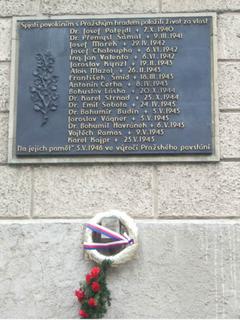Prague Trip Report, Part 6 (more Big 5th Day)

May 5th (piet kveten) was also the 60th anniversary of the uprising in Prague against the Nazi occupation troops, who had held the country since 1938 and were desperately trying to hold on to their conquests as allied forces approached in early May 1945. At noon, ferociously loud sirens/air raid horns were sounded throughout the city to remind Praguers and visitors of the anniversary. Re-enactments and ceremonies were held during the day and the following weekend.
We saw plaques throughout town that honored martyrs who died fighting the Nazis and noted that small golden wreaths had been placed adjacent to the plaques. Josef Kuník was the name of the Czech who died fighting the Germans near the tram stop, Albertov, for our hotel. Interestingly, perhaps at least a few of the resistance fighters appear to have had German-sounding surnames. Before the war, Czechoslovakia, which before nationhood in 1918 had been part of the Austro-Hungarian Empire, had a large population of ethnic Germans. Many of them were initially enthusiastic about the Nazi takeover in 1938, and some of them had collaborated to sabotage Czechoslovakia and abet the Nazi takeover, but as the war and occupation dragged on many of these German-Czechs became less and less enthusiastic about the Führer and his minions.
US forces under General Patton did liberate a small part of western Czechoslovakia from the Germans, but later had to withdraw as Czechoslovakia fell under the Soviet zone of post-war occupation. It was a few days after the uprising before Soviet troops entered Prague, so Praguers endured some days of bitter fighting.
Fortunately, damage to Prague was very limited during World War II and the city came out of the conflict relatively unscathed. In February of 1945 (after a less serious bombing some time before), an allied bombing mission to Dresden went astray and bombed Prague, damaging or destroying some churches and other buildings. I think the allied bombers also managed to knock out a plant that was churning out light bulbs vital to the Third Reich. I think the Nazis also blew up a token building or few on their way out of Prague in defeat in 1945. More seriously, many thousands of Czechs were killed by the Nazis during the war and Prague’s Jews were among the many victims of Nazi genocide. Whole villages, such as Lidice after the assassination of Hitler’s henchman Heydrich, were wiped out by Nazi reprisals and the Terezin (Theresienstadt, familiar to viewers of “War and Remembrance” based on Herman Wouk’s novel of the same name) transit camp was the site of the “golden ghetto” designed to fool outsiders before its residents were shipped off to the Auschwitz extermination camp (Oswiecim) in southern Poland.


0 Comments:
Post a Comment
<< Home